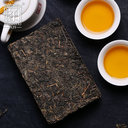Tea: 1953 Fucha Anhua Dark Tea Royal Fu Tea Brick
| Brand: | Baishaxi |
| Style: | Dark Tea |
| Region: | Hunan, China |
| Caffeine: | Caffeinated |
| Loose? | Compressed |
| # Ratings: | 1 View All |
Reviewer: Whiskey

✓ 45 teas reviewed
✓ 9 of Dark Tea
✓ 28 of Pure Tea (Camellia sinensis)
✓ 1 of Baishaxi
✓ 2 from Hunan, China
✓ 13 from China
Review of 1953 Fucha Anhua Dark Tea Royal Fu Tea Brick
February 13th, 2018
| Aroma | Flavor | Value | Total |
| 7 of 10 | 3 of 5 | 3 of 5 | 80 of 100 |
| Very Good | Fair | Reasonable |
I wanted to redo this review because I gave this tea some time to age, suspecting that the smokiness would diminish, and it did. So, the experience of drinking this tea is a very different one now. I managed to brew it using a gaiwan, not a teapot with a mesh strainer, and there still wasn't too much sediment. The taste is very much the same, but the consistency of the tea has greatly evolved.
The date on the tea is "2017/12/23" and it is January 20th, 2019 today. So, that's around two years since production.
I used 5g of tea in a 110ml gaiwan when brewing it (with 100ºC water). I rinsed it generously — 5-10s — swishing the water around before discarding it. I also made sure that the leaves were peeled apart as much as possible (the brick is a bit dense, so it's not easy). I brewed cups for short bursts — 10s to start, then 10-15s, then around 20s. The taste was like a cross between lapsang souchong and gunpowder green tea. The effect of the tea was strong. I find that dark (non-pu-erh) teas are a bit like this for me, particularly at first. They will have a strong, tea drunk-like effect the first few times I drink them, then it will fade. The effect of dark (non-pu-erh) teas will last longer with me, while I've had pu-erh teas which have had that effect on me only once or twice before I adjusted to them. It could be due to different strains of bacteria and fungus which are associated with the aging process. There may be more variety in the dark (non-pu-erh) teas, while those in the pu-erh teas may be more similar. Anyway, there was a strong effect with this one. I had only three cups out of it. It didn't have any 'off' notes that I could tell. There was a bit of that smoky sediment, but not much. Under normal circumstances, I raise the amount of dark tea I use from 2g to 8g, with the steps between depending largely on the strength of the tea. But, this tea is quite strong at 5g, so I don't think I'd need more to brew it. Having three cups of this, brewing 5g of tea, more than satisfied me. It's just a very strong taste. Perhaps that will change as it ages, but that is what I'd stick with for now. For someone hesitant about this, it might be better to start with a smaller amount (I've had some dark teas I've had to brew with only 2g per 300ml of water). If you don't like smoky tastes, though, this is not a tea to try. There's just no way around that note with this tea, it's really the primary flavor here.
For pairings, I'd recommend this with beef, tuna (a filet), or bacon. (I don't eat all of these anymore, but I have in the past and this smoky, savory tea flavor does go well with them.) It also seems like it might go well with black peppercorns, which are a good spice for beef or tuna. The hot water it requires and the smoky taste make it reminiscent of campfires and very suitable for helping one to keep warm in the cold winter months.
I'd definitely recommend this one for a try, but be sure to let it age first. The smoky sediment is very unpleasant when it's young and caused me to cough quite a lot (it's not something I'd wish on others and it couldn't be overcome with a fine mesh strainer, either — it just needs time).
Note: When I checked the brick today (January 2019), the abrasions on it where I had dug into it with a pu-erh tea needle were covered with "golden flowers" — the type of mold that is often bragged about on product pages for this variety of tea. (I looked at it with a magnifying lens to verify it. The color/shape is the same as depicted on product pages. It also bears no resemblance to the other varieties of undesirable mold that I've observed on dark teas.) I just wanted to note this. I didn't personally expect it. The outside of the brick had no "golden flowers" on it. It also did not show this until recently. It does not have any musty smell that I can detect, though the strong smokiness of the tea might be covering that up.


